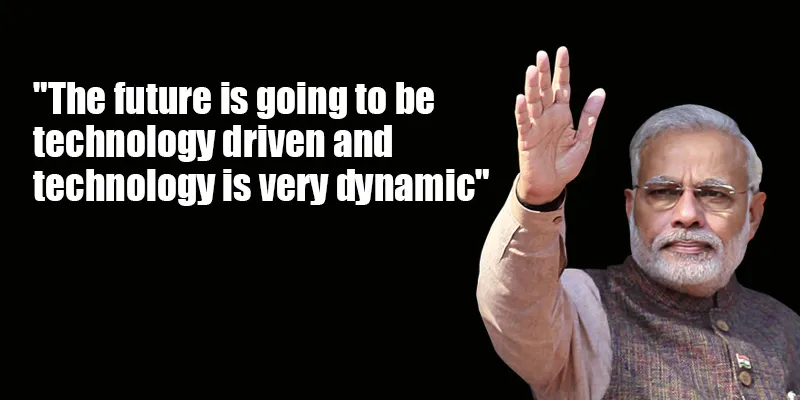Are the Modi Government’s adopted schemes holding out on their promises?
When it comes to the politics of the dynamic Narendra Damodardas Modi, there are three types of people. There’s the group that passionately hates Narendra Modi, believing that he will lead India into an ‘autocratic democracy’. There’s the group that is religiously for Modi and his ‘acche din’, who believe that the country has prospered greatly since he took reign two years ago. Finally, there’s a third group who don’t particularly like or hate him, but who grudgingly accept that he has done quite a bit for our diverse nation.
Narendra Modi had made some very big promises of ‘acche din’ in his campaign, challenging the former Government for its inconsistency in upholding the many projects it had implemented but abandoned mid-way. He swore to the millions who voted for him that he would change the face of the nation – starting with the endorsement of many schemes he believed would make India ‘self-reliant’.

Although some of these have fallen flat, there are still many notable schemes which he introduced or remodelled that are currently creating positive change in our country. Here are an evaluation of his more successful ones.
Swachh Bharat Abhiyan
Synonymous with his ‘acche din’, the Swachh Bharat Abhiyan introduced by Modi on Gandhi Jayanti in 2014 is definitely one of his more effective ones. This is a modification of the former Nirmal Bharat Programme that the previous Government had left incomplete.
How it works: The Government propagates a clean environment through this campaign by providing better toilet and sanitation facilities in all rural and remote areas. It holds workshops and sessions to create public awareness about waste management and sanitation and also drives initiatives to clean the streets, roads and encroachments of the many urban cities that make up the country.
Aim: To make India a clean country by 2019 – the 150th birthday of Mahatma Gandhi.
Digital India
Modi has proved time and again that he knows how to use digital media to his advantage, as seen from his use of various social media platforms to promote his campaign for the 2014 General Elections. Hence, his plan to turn India into a more digital-friendly country is only a natural part of his wish-list. Launched on 21 August, 2014, the programme has picked up considerably since, even enlisting several recently launched government apps to be a part of it.
How it works: The Programme attempts to connect all Government Departments and the Indian public, digitally or electronically, for better national governance for all reaches of the country. Its three main components are Digital Infrastructure, Digital Literacy and Digital Delivery of Services. To this end, Modi has also launched many apps like MyGov ,which contains features that allow the public to relay and redress their grievances to the Prime Minister and receive replies, among many other things.
Aim: Bringing the public closer to the Government through the use of digital media for a better understanding of their day-to-day lives to consequently effect better governance. It also aims to reduce paperwork by making all the Government services available to the public electronically and to connect all the rural areas through internet networks. The programme aims to be completed and in force by 2019.
Clean Ganga Campaign
In a 2007 report, India was listed fifth as having the “most polluted rivers in the world” – a shame considering we have the Holy Ganges flowing through our vast landscape. Moreover, the river is the source of livelihood for more than a third of the country’s population. To change the face of this extremely pressing issue and to free the Ganges of the copious amounts of unsolicited waste that is thrown into it every day, Modi has launched the Clean Ganga Campaign, formerly introduced as the Ganga Action Plan under the Rajiv Gandhi Government.
How it works: The programme includes measures like capturing sewage from all the sources where it enters the river, working primarily on gravity instead of electricity, removing all harmful bacteria present so that citizens don’t suffer from cholera, typhoid and various intestinal diseases, reclaiming water, precious nutrients and energy for re-use and facing the challenge of the volume of sewage being dealt with into the foreseeable future. The Modi Government has enlisted the help of various social organisations to spread awareness and achieve the mission of the Clean Ganga Project.
Aim: To clean up the National River of the country by 2018.
Although the three projects mentioned here are the more popular and active programmes implemented by the Modi Government, there are several smaller projects that have taken root since his ascent to power which are just as integral to its governance. Some of these include the Smart City Mission, where the Union Cabinet will provide Rs 48,000 crores to a select list of 98 cities for their infrastructural development over the next five years; the Atal Pension Yojana, which looks to provide monthly pension to subscribers from 60 years of age and the Make in India mission, to increase the rate of employment in India and make her self-reliant by creating more job opportunities, allowing FDI in the country and recovering loss-making Government firms.







